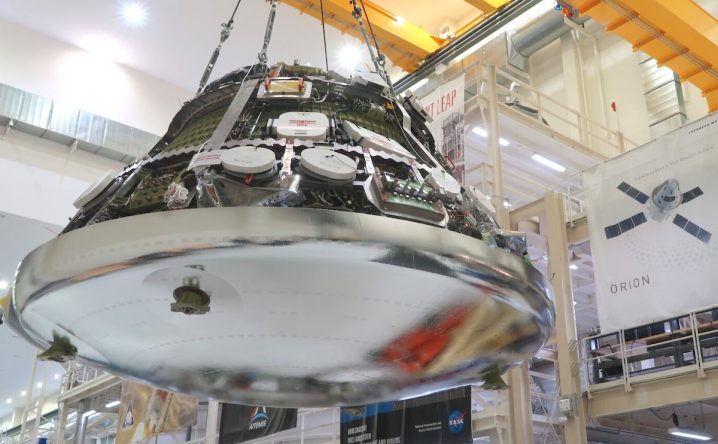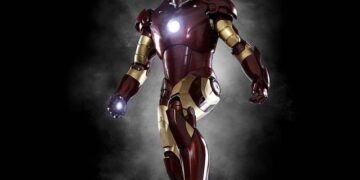![]()
By
Trevor Mogg
October 24, 2023 11:05PM
 Integration of the crew and service modules for the Artemis II Orion spacecraft was recently completed at NASA’s Kennedy Space Center in Florida. NASA
Integration of the crew and service modules for the Artemis II Orion spacecraft was recently completed at NASA’s Kennedy Space Center in Florida. NASA
NASA’s crewed Artemis II moon mission took an important step forward recently when the crew capsule was linked together with the service module.
The integration took place at the Neil Armstrong Operations and Checkout Building at NASA’s Kennedy Space Center in Florida last week and was reported by NASA in a post on social media on Tuesday.
“After successfully completing hardware installations and testing over the past several months, engineers connected the two major components of Orion that will fly NASA astronauts Reid Wiseman, Victor Glover, and Christina Koch, along with CSA (Canadian Space Agency) astronaut Jeremy Hansen, on a mission around the moon and bring them home safely,” NASA said.
The all-important service module is located beneath the Orion crew capsule and during next year’s Artemis II mission will provide propulsion, power, thermal control, and water and air for the four astronauts. The service module fits inside a housing surrounded by three spacecraft adapter jettison fairing panels. During launch, these panels protect against severe heat, wind, and acoustics, but once Orion is free from Earth’s atmosphere, the fairing panels are jettisoned to allow the spacecraft’s solar arrays to unfold. Just before the crew capsule enters Earth’s atmosphere at the end of the mission, the service module detaches and burns up.
The next job of the Artemis II mission team is to power up the combined crew and service module for the first time to confirm that it’s in perfect working order. After that, altitude chamber testing will be conducted on Orion, a process that subjects the spacecraft as closely as possible to the harsh conditions that it will experience in space.
The Orion spacecraft traveled to space for the first time in the uncrewed Artemis I mission toward the end of last year, so engineers have a good idea of how the current spacecraft will respond to the upcoming tests.
The crewed Artemis II mission, slated for November 2024, will follow the same path of Artemis I, coming within about 80 miles of the lunar surface before heading out further into space and then returning home. The mission is expected to last about 10 days.
Following this first flight with a crew onboard, NASA is planning to launch the Artemis III mission in 2025, taking the first humans to the lunar surface since the final Apollo mission in 1972.
Editors’ Recommendations
Check out the NASA EV that will drive Artemis crew (partway) to the moon
NASA photo shows off engines that will power next crewed lunar mission
Here’s where NASA will land astronauts on the moon
NASA hears Voyager ‘heartbeat’ as it tries to reconnect with spacecraft
NASA accidentally loses contact with legendary Voyager 2 spacecraft
Not so many moons ago, Trevor moved from one tea-loving island nation that drives on the left (Britain) to another (Japan)…
Trio of Orion spacecraft prepped for NASA moon missions

NASA has shared an image of three spacecraft that will play a central role in its next three Artemis missions to the moon.
Having already successfully tested the Orion spacecraft on a lunar flyby at the end of last year after being blasted into space by NASA’s new Space Launch System rocket, the American space agency is now overseeing the building of three more Orion capsules for upcoming Artemis missions.
Read more
NASA performs critical tests for Artemis V moon rocket

NASA is performing hot fire tests of the new RS-25 engines that will power the agency’s Space Launch System (SLS) rocket toward the moon in the Artemis V mission, currently scheduled for 2029.
“NASA entered the stretch run of a key RS-25 certification engine test series with a successful hot fire [on] June 1, continuing to set the stage for future Artemis missions to the moon,” the agency said in a post on its website.
Read more
NASA’s moon astronauts are ready to start training

From left to right: Jeremy Hansen, Victor Glover, Reid Wiseman, and Christina Hammock Koch. NASA
Training is about to get underway for the first lunar-bound crewed mission in 50 years.
Read more
>>> Read full article>>>
Copyright for syndicated content belongs to the linked Source : Digital Trends – https://www.digitaltrends.com/space/nasas-artemis-ii-moon-capsule-receives-vital-component/
















